Desert Blooms
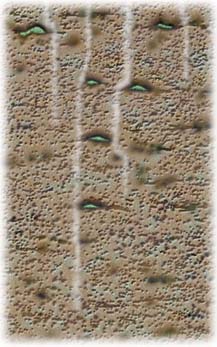 |
Deep beneath the surface, microbes live in pores in Columbia River basalts- lying dormant in the darkness until water seeps down to bring nutrient heavy-metal and petroleum wastes.
|
|
 |
Farming isn't always so straightforward. At the Radioactive Waste Management Complex in the Idaho National Engineering and Environmental Laboratory, microorganisms live in basalt rocks 75 meters beneath the surface, with no obvious source of nutrients.
"Columbia River basalts are quite limited in organic carbon and other nutrients," says Hoi-Ying Holman, a chemist and engineer with CEB, "but dense clusters of microorganisms live in the pores and fractures of the rock. Most of the time they are in a resting state. When water infiltrates from rain or melting snow, a burst of nutrients reaches them through fissures in the rock, and they bloom like flowers in the desert."
When Holman first began to study ways of cleaning up the site, which was established in the 1950s as a place to store solid radioactive waste, there were two hypotheses to explain the observation that the toxic hexavalent form of chromium was reduced in the basalt to the much less harmful trivalent form, which is insoluble and unable to cross cell membranes. The hypothesized "chemical mechanism" depended on reactions with iron compounds in the basalt; it had no role for organisms. Yet the "biological mechanism" was full of uncertainties about which organisms might be involved and what metabolic processes were important.
In the laboratory, Holman and her colleagues were able to isolate and purify 85 strains of microorganisms from crushed basalt samples. Several had the ability to reduce chromium-especially in the presence of toluene, a common product of leaking fuel tanks and one of the contaminants at the site.
The degradation proceeded stepwise, and many organisms encountered bottlenecks that slowed the process. Finally one strain of bacteria emerged as champion. "Arthrobacter oxydans was the fastest, but we needed to study its behavior in undisturbed natural communities in the basalt."
The techniques to do the job had to be invented. One challenge was to cut disks from the basalt cores, thinner than sliced salami, without significantly disturbing the resident microorganisms.
At the suggestion of CEB leader Jennie Hunter-Cevera, who used to saw geodes as a hobby, Holman and Andre Mei, a machinist in the Technical Services Department with years of experience preparing ultra- thin materials, modified a surplus diamond saw from the ceramics shop.
A diamond-coated wire rotates slowly beneath a counterbalanced basalt core; only the core's own feather weight holds it against the water-cooled cutter. The whole Rube Goldberg rig sits under a sterile hood. "It looks funny," Holman says, "but it does the job."
Holman needed a nondestructive way to study the interactions between environmental toxins such as chromium and the microorganisms on the rock surfaces. "By coincidence I found myself standing in for Jennie Hunter-Cevera at an ALS users' meeting and heard them talking about doing 'nondestructive tests'-which for them meant not grinding up the samples. For me it suggested not killing the bugs." Although the ALS's main mission is to provide brilliant soft x-ray and ultraviolet light beams, an infrared beamline was under construction at the time.
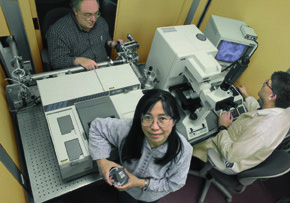 |
Hoi-Ying Holman with Wayne McKinney (left) and Michael Martin. Holman, McKinney, Martin, and Dale Perry pioneered nondestructive techniques for studying rock-inhabiting microbes.
|
|
 |
"The infrared is the end of the spectrum not usually associated with synchrotrons," says Holman, "but for us it's perfect-and not only because it's nondestructive. You have an extremely complicated spectrum in the ten-micrometer region. We identified markers in this spectral region that tracked the key compounds which undergo changes during the bioremediation process. We could resolve the spectrum in time, to follow the different steps of the reduction, and also in space, to see exactly where the reactions were happening."
When beamline 1.4.3 was commissioned, Holman and her colleague, chemist Dale Perry, were among its earliest users; they worked with Michael Martin and Wayne McKinney, the physicists who had designed the infrared beamline.
Their infrared spectromicroscopy studies, combined with conventional microbiological techniques, revealed that Arthrobacter oxydans can reduce highly mobile and toxic hexavalent chromate to less mobile, less toxic trivalent chromium through two or more distinct chemical steps; that reduction is much accelerated in the presence of toluene; and that high reduction rates occur only on surfaces that are densely populated with microorganisms.
Under the Inland Sea
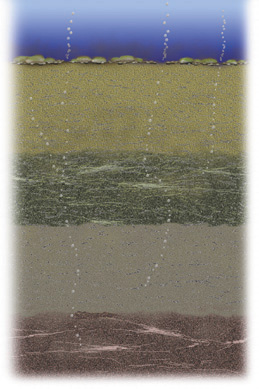 |
Core samples of sediments deep beneath the floor of Lake Baikal include gas bubbles, evidence of methane-generating microbes.
|
|
 |
Last October, CEB's Tamas Torok, a microbiologist in Life Sciences, traveled to Lake Baikal, the largest freshwater lake in the world, on a project underwritten by the Department of Energy's Initiatives for Proliferation Prevention. Torok and the project's principal investigator, Jennie Hunter-Cevera, dubbed it a search for "rare and unknown organisms."
"Our Russian colleague, Vladimir Repin, had suggested we call it the search for 'ancient' organisms. We thought maybe that was stretching a point," says Torok. "Yet Lake Baikal is one of the most isolated ecosystems in the world-a place where evolution may have proceeded very slowly. Maybe ancient was the right word after all."
Torok notes that "many unique species of plants and animals are found in and around Lake Baikal, so we were confident we would find unique microorganisms as well." He gathered samples from Lake Baikal's cold deep waters and from hot springs at its margins.
Then he got an unexpected opportunity to look for organisms deep in lake-bottom sediments, when he met scientists from the international Baikal Drilling Project sponsored by agencies in Russia, Germany, Japan, and the U.S. For several winters the consortium's researchers had been collecting cores and studying variations in pollen grains, diatoms, biogenic silica, and other features of the sediment layers. Already they had succeeded in constructing a continuous record of the region's climate for the last five million years.
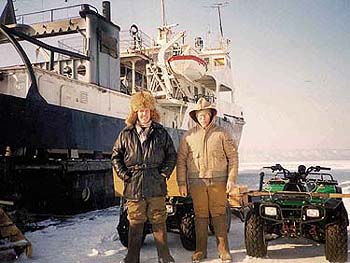 |
Vladimir Repin and Tamas Torok beside the ice-breaker Baikal, frozen in the ice.
|
|
 |
"There was no microbiological aspect to their work, however," says Torok. "I proposed to piggyback on what they had done. Although they generously offered me samples from cores they had drilled in January of '98, I hadn't been there for the drilling, and I didn't know the potential for contamination. So in February of '99 I went back."
Earlier that winter the icebreaker Baikal had towed the barge-mounted drill rig to a site
38 kilometers offshore above the Ambassador Bank, whose top is 200 meters beneath the surface; there both vessels waited until they were frozen solid in the ice. Four immense electric generators powered the operation, which makes use of a lightweight aluminum derrick and hydraulic-piston corers designed not to disturb the sediment in the cores; all equipment and supplies were stored aboard. "When you are in the middle of nowhere you have to have everything," Torok remarks.
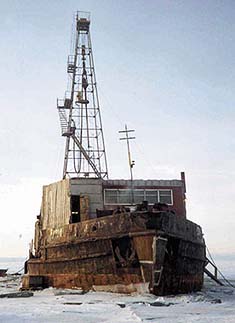 |
The Baikal Drilling Project's barge-mounted rig brings up core samples from the lake floor
|
|
 |
Torok was on hand for two weeks in the middle of the Siberian winter, while cores two meters long were brought up from as deep as 170 meters below the top of the ridge; the coring eventually reached 300 meters into the sediments. "We designed procedures to handle the cores as soon as they were lifted, as aseptically as possible under field conditions." Later they were transported to Irkutsk, characterized, and carefully divided among the scientists from the various countries.
At Berkeley Lab, Torok, Hunter-Cevera, and their CEB colleagues will be performing a series of tests on their share of the samples for the rest of the year. "We'll extract DNA for gene sequencing and biomarker analysis to identify strains that can't be grown in the lab. We'll also isolate and grow as many as we can on lean media, as close as possible to natural conditions-such as the temperature deep in the lake, which is four or five degrees C."
Meanwhile, novel restriction enzymes have already been found among the organisms collected in the Baikal region in October of 1998, as reported in Europe this spring by their colleague, microbiologist Vladimir Repin; Torok and Hunter-Cevera will announce further results at
the International Symposium on Subsurface Microbiology in Colorado this August. "Twenty percent of the organisms we've isolated are unique, with no similarity to organisms in data bases. We're screening these and others for enzymes and secondary metabolites of biotechnological interest."
The sediment cores, too, will almost certainly reveal new organisms; they have already shown signs of life in the form of bubbles of gas, trapped inside the sterile plastic liners that seal the cores as they emerge from the deep. "It's mostly methane," says Torok. "The likely source is methanogens living deep in the sediment."
|



![]()

![]()

![]()